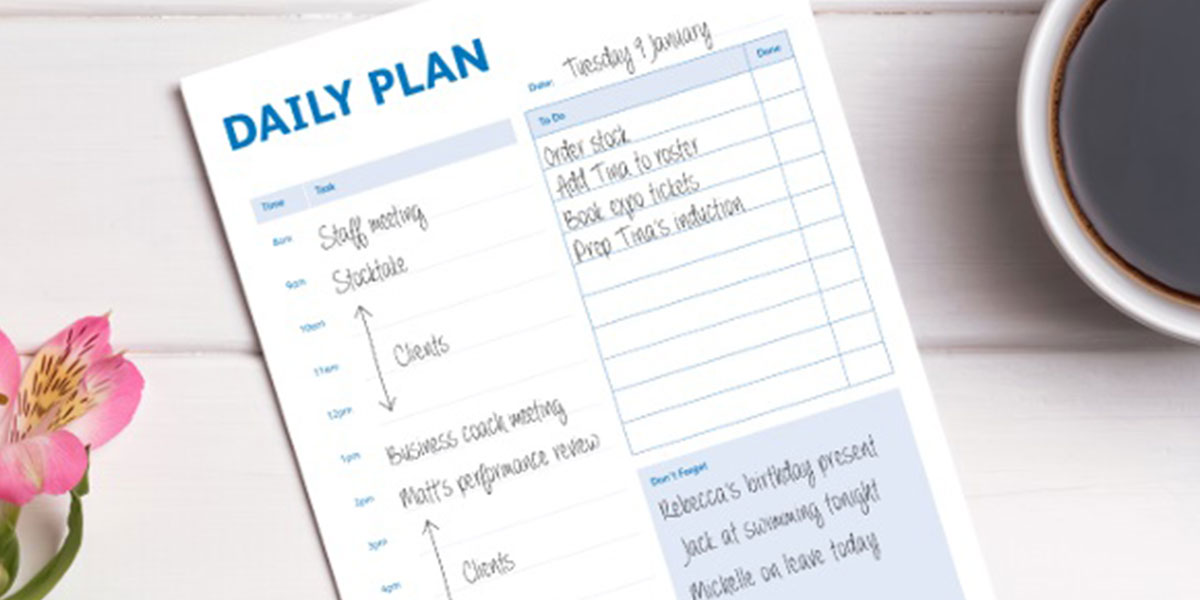
Table of Contents
ToggleImportance of Planning and Structure for Daily Tasks and Goals
Why Planning and Structure Matter
Planning and structuring your daily tasks and goals are crucial for staying organized, focused, and on track. It helps you prioritize what needs to be done, allocate time effectively, and ensure you make progress towards your objectives.
Introducing the Daily Planner as a Time Management Tool
What is a Daily Planner?
A daily planner is like your personal assistant, helping you map out your day, set goals, and track your progress. It's a powerful tool that keeps you organized and focused on what matters most.
How a Daily Planner Helps
- Increased Productivity: By planning your day in advance, you can optimize your time and tackle tasks efficiently.
- Reduced Stress: Knowing what needs to be done and having a plan in place can alleviate the feeling of being overwhelmed.
- Improved Focus: A daily planner keeps you on track and minimizes distractions, allowing you to concentrate on your priorities.
- Sense of Accomplishment: Checking off tasks from your to-do list gives you a sense of achievement and motivates you to keep going.
Choosing Your Perfect Planner
Digital vs. Paper Planners
When it comes to choosing between a digital planner or a paper planner, there are pros and cons to consider. Digital planners offer the convenience of accessibility from multiple devices, easy editing, and the ability to set reminders.
However, paper planners provide a more tactile experience, allowing you to physically write down your thoughts and plans. They can also be less distracting than digital devices.
Ultimately, the choice between a digital planner or a paper planner comes down to personal preference and the features that best suit your needs.
Some popular digital planner apps:
- GoodNotes 5 (iOS, iPadOS, macOS): A versatile note-taking app with features ideal for digital planning, including customizable templates, handwriting recognition, and drag-and-drop functionality.
- Notability (iOS, iPadOS, macOS): Another popular note-taking app that allows importing planner PDFs and offers features like digital stickers, hyperlinks within your planner, and audio recording for note-taking alongside your schedule.
- Notion (Web, iOS, iPadOS, Android, macOS, Windows): A powerful all-in-one workspace app that can be customized for digital planning. Create flexible layouts with to-do lists, calendar views, habit trackers, and goal sections that integrate seamlessly with other project management features.
- Digital Planner Apps by Passion Planner (iOS, iPadOS, Android): These apps offer pre-designed digital versions of the popular Passion Planner layouts, providing a familiar format for digital planning enthusiasts.
- TimeTree (Web, iOS, iPadOS, Android): A calendar-focused app that allows detailed scheduling and integrates to-do lists and reminders for a more comprehensive daily planning experience.
Features to Consider
When selecting a planner, it's important to consider the features that will help you stay organized and on track.
Some key features to look for include hourly schedules for time management, to-do list sections for task planning, habit trackers for building routines, and goal setting sections for long-term planning.
Depending on your specific needs, you may also want to look for planners with project management tools, note-taking sections, or even built-in calendars.
Finding the Right Fit
Choosing the perfect planner is all about finding one that aligns with your individual needs and workflow. Consider your planning style, the types of tasks you need to manage, and the level of detail you prefer.
If you're a visual person, you may prefer a planner with colorful layouts and plenty of space for notes. If you're more of a minimalist, a simple, clean design may be more appealing. Take the time to explore different options and don't be afraid to try out a few different planners before settling on the one that works best for you.
Free Printable Planner: Click here
Building Your Daily Plan
Morning Ritual: Kickstart Your Day with a Productive Routine
Starting your day with a well-planned morning ritual can set the tone for a productive and successful day ahead.
By establishing a consistent routine, you can boost your energy, focus, and overall well-being. Your daily planner should include time for activities like meditation, exercise, and a healthy breakfast to help you feel refreshed and ready to tackle your tasks.
Prioritization Techniques: Tackle What Matters Most
With so many tasks on your plate, it's crucial to prioritize effectively.
The Eisenhower Matrix is a powerful tool that helps you categorize your tasks based on their importance and urgency. By focusing on high-priority, high-impact tasks first, you can make significant progress towards your goals.
Another method is the ABC method, where you assign tasks with A, B, or C priorities based on their importance.
Time Blocking: Maximize Focus and Minimize Distractions
Time blocking involves dividing your day into dedicated blocks of time for specific tasks or projects. This technique helps you stay focused and minimizes distractions by creating a clear structure for your day.
By allocating specific time slots for deep work, meetings, and breaks, you can optimize your productivity and ensure that you make steady progress on your most important tasks.
Schedule Flexibility: Embrace the Unexpected
While planning is essential, it's also important to acknowledge that unexpected events and interruptions can occur.
To account for this, build in buffer time in your daily schedule to accommodate any unforeseen circumstances or tasks that may arise. This flexibility will help you stay calm and adaptable when faced with last-minute changes or urgent requests.
Keeping Your Planner on Track
Daily Review & Adjustments
It's crucial to make a habit of reviewing your plan every day. Take a few minutes to assess how your day went, what tasks you completed, and what still needs to be done.
This daily review helps you stay on track, prioritize effectively, and make any necessary adjustments to your schedule. By doing this regularly, you can ensure that you are making progress towards your goals.
Dealing with Setbacks
Setbacks are a natural part of life, but how you handle them can make a big difference. When unexpected events occur or tasks are missed, it's important to have strategies in place to deal with them.
You can reschedule tasks, delegate them to others if possible, or simply adjust your plan to accommodate the changes. By being flexible and proactive in dealing with setbacks, you can keep moving forward despite challenges.
Weekly Planning
Weekly planning sessions are a great way to set yourself up for success. Take some time at the beginning of each week to review your goals, tasks, and projects.
Use this time to prioritize your activities, allocate time for important tasks, and plan ahead for any upcoming deadlines or events.
By incorporating weekly planning into your routine, you can stay organized, focused, and on top of your responsibilities.
Habit Tracking
Habit tracking is a powerful tool for building positive routines and achieving long-term goals.
By tracking your habits, you can see patterns in your behavior, identify areas for improvement, and stay motivated to make positive changes.
Whether it's exercising regularly, reading more often, or practicing a new skill, habit tracking can help you stay accountable and make progress towards your long-term goals.
Some Points To Remember For Daily Planner
- Choose the Right Daily Planner App: Select a daily planner app that suits your needs and preferences. Apps like Plaky, Routine, My Daily Planner, and Todoist offer various features for organizing tasks efficiently.
- Customize Your Daily Schedule: Tailor your daily schedule to fit your routine. Consider using a daily planner template that aligns with your lifestyle, whether you prefer a simple to-do list layout or a detailed hourly breakdown.
- Prioritize Tasks: List your tasks and prioritize them based on importance. Categorize tasks to manage them effectively and avoid feeling overwhelmed.
- Set Deadlines and Goals: Assign deadlines to tasks and set clear goals for each day. Tracking your progress and visualizing accomplishments can enhance your productivity and motivation.
- Track Progress and Reflect: Use features like progress tracking, productivity trends, and completed tasks archives to monitor your daily, weekly, and monthly achievements. Reflecting on your progress can help you stay motivated and focused.
- Balance Work and Personal Life: Allocate time for both work-related tasks and personal activities in your daily schedule. Ensure you have a well-rounded plan that includes time for self-care, exercise, socializing, and other personal priorities.
By following these steps and utilizing the features offered by daily planner apps and templates, you can design a daily planner that suits your needs, enhances your time management skills, and boosts your overall efficiency throughout the day.
Conclusion
By incorporating a daily planner into your routine, you can transform that chaos into calm control. You'll experience a newfound sense of productivity, reduced stress, and the satisfaction of achieving your goals.
But a daily planner is just a tool – it's up to you to wield it effectively. If you're looking for further inspiration and practical tips, check out these resources:
- The Muse: How to Use a Daily Planner to Boost Your Productivity (https://www.themuse.com/advice/productivity) offers a great breakdown of incorporating a planner into your work-from-home routine.
- James Clear – Atomic Habits (https://jamesclear.com/) dives deep into the science of habit formation, a key element of using a planner for long-term success.
So, what are you waiting for? Grab your planner (digital or paper, the choice is yours!), and start crafting your path to a more productive and fulfilling day. You've got this!



